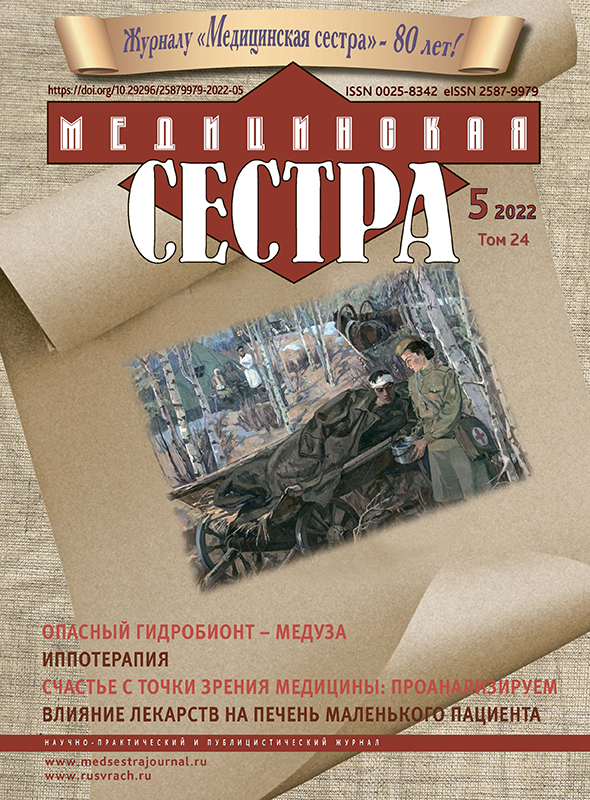Drug-induced liver damage: collisions of the drug-liver tandem in pediatric practice
- Authors: Kharitonova L.A.1, Grigoriev K.I.1,2, Bogomaz L.V.1
-
Affiliations:
- N.I. Pirogov Russian National Research Medical University
- «The Nurse» journal
- Issue: Vol 24, No 5 (2022)
- Pages: 50-56
- Section: Articles
- URL: https://journals.eco-vector.com/0025-8342/article/view/114057
- DOI: https://doi.org/10.29296/25879979-2022-05-09
- ID: 114057
Cite item
Abstract
Peptic ulcer is a chronic relapsing disease characterized by the formation of a defect in the wall of the stomach and / or duodenum. The incidence of upper gastrointestinal bleeding is 30150 per 100,000 adults per year, and in most cases they result in hospitalization. In 68% of cases, people are over 60 years old, and 27% are over the age of 80 years. Mortality from PU continues to be high (5-10%, up to 15%). The cause of occurrence is a combination of predisposing internal (genetic markers, microflora) and external factors. A significant contribution to the development of peptic ulcer is prescribed by the bacteria Helicobacter pylori. At the moment, as a conservative treatment, it is recommended to focus on antibiotic therapy in order to eliminate the pathogen and reduce its pathological effect on the wall of the affected organ. Of the available spectrum of antibiotics, metronidazole is considered the most suitable, since it has high activity against Helicobacter pylori when administered orally, efficiency in short courses of treatment, high bioavailability, good penetration into organs and tissues.
Full Text
About the authors
Lyubov A. Kharitonova
N.I. Pirogov Russian National Research Medical University
Email: k-i-grigoryev@yandex.ru
MD, Professor, Head of Department Pediatrics with infectious diseases in children, Faculty of Additional Professional Education
Konstantin I. Grigoriev
N.I. Pirogov Russian National Research Medical University; «The Nurse» journal
Author for correspondence.
Email: k-i-grigoryev@yandex.ru
MD, Professor of Department Pediatrics with Infectious Diseases in Children, Faculty of Additional Professional Education N.I.; Editor-inChief
Lyudmila V. Bogomaz
N.I. Pirogov Russian National Research Medical University
Email: k-i-grigoryev@yandex.ru
Candidate of Medical Sciences, Associate Professor of the Department of Pediatrics with Infectious Diseases in Children, Faculty of Additional Professional Education
References
- Постников С.С., Грацианская А.Н., Костылева М.Н. Лекарственные поражения печени у детей. Практика педиатра. 2013; № 12 (декабрь): 9-15
- Борзакова С.Н., Рейзис А.Р. Принципы диагностики и терапии лекарственно-индуцированных поражений печени у детей, больных туберкулезом. Рос вестн перинатол и педиатр 2018; 63:(3): 91-97. doi: 10.21508/1027-4065-2018-63-3-91-97
- Ларионова В.Б., Снеговой А.В. Возможности коррекции лекарственной печеночной токсичности при лечении больных с опухолями системы крови. Онкогематология 2020;15(4):65-81
- Остроумова О.Д., Ших Е.В., Ших Н.В., и др. Лекарственно-индуцированное поражение печени с холестазом в практике невролога и психиатра. Неврология, нейропсихиатрия, психосоматика. 2022; 14(1):14-21. doi: 10.14412/2074-27115.2022-1-14-21.
- Ивашкин В.Т., Барановский А.Ю., Райхельсон К.Л. и др. Лекарственные поражения печени (клинические рекомендации для врачей). Российский журнал гастроэнтерологии, гепатологии, колопроктологии. 2019; 29(1):85-115. doi: 10.22416/1382-4376-2019-29-1-101-131
- Tisdale J.E., Miller D.A., eds. Drug-induced diseases: prevention, detection, and management. 3rd ed. Bethesda, Md: American Society of Health-System Pharmacists; 2018: 1400 р.
- Коренская Е.Г., Парамонова О.В. Лекарственные поражения печени - одна из важных проблем у коморбидного пациента. Consilium Medicum. 2019; 21 (8): 78-83. doi: 10.26442/20751753.2019.8.190355
- Bjrnsson E.S. Risk of drug-induced liver injury from tumor necrosis factor antagonists. Clin Gastroenterol Hepatol 2015; 13 (3): 602-8. doi: 10.1016/j.cgh.2014.07.062.
- Fisher K, Vuppalanchi R, Saxena R. Drug-induced liver injury. Arch Pathol Lab Med 2015; 139 (7):876-87.
- Пиманов С.И., Макаренко Е.В. Идиосинкразические лекарственные поражения печени: диагностика и лечение. Мед. совет. 2017; 5: 100-7.
- Reporting adverse drug reactions definitions of terms and criteria for their use. Geneva: CIOMS. 1999. 146 p.
- Burt A.D., Portmann B.C., Ferrell L.D. MacSween’s Pathology of the Liver, 6-th Edition, 2012: 645-760.
- Ortega-Alonso A., Stephens C., Lucena M.I., Andrade R.J. Case characterization, clinical features and risk factors in drug-induced liver injury.Int Mol Sci. 2016; 17(5):714. doi: 10.3390/ ijms17050714
- Chitturi S., Farrell G.C. Drug-induced cholestasis. Semin Gastrointest Dis. 2001; Vol. 122: 113-24.
- Еремина Е.Ю. Лекарственные поражения печени. Практическая медицина. 2014; 77 (№1, март): 20-25. Eremina E.Yu. Drug-induced liver injury. Prakticheskaya meditsina. 2014; 77 (№1, March): 20-25 (In Russ.)
- Лупаш Н.Г., Шакарян К.А., Маталаева С.Ю., и др. Желчнокаменная болезнь у детей раннего возраста - лечить консервативно или оперативно? Российский вестник перинатологии и педиатрии. 2018; 63(4): 63-68. https://doi.org/10.21508/1027-4065-2018-63-4-63-68.
- Запруднов А.М. Синдром Рея в детском возрасте. Парацетамол в педиатрической практике. М.: Стерлинг хелс, 1995: 59 с.
- Запруднов А.М., Григорьев К.И., Харитонова Л.А., и др. Проблемы и перспективы современной детской гастроэнтерологии. Педиатрия. 2016; т. 95. № 6: 10-18.
- Zimmerman HJ. Hepatotoxicity: The adverse effects of drugs and other chemicals on the liver. 2nd edition. Philadelphia, PA: Lippincott Williams & Wilkins; 1999. 789 p.
- Барановский А.Ю., Кондрашина Э.А., Марченко Н.В., и др. Лекарственные поражения печени. Клинические рекомендации для врачей СПб.: 2017: 116 с.
- Казюлин А.Н., Вельшнер Л.З., Бяхов М.Ю., и др. Эффективность сопроводительной терапии адеметионином (гептралом) при проведении противоопухолевой лекарственной терапии у больных с онкологическими заболеваниями различной локализации. Злокачественные опухоли. 2013; № 3: 16-34.
- Сандлер Ю.Г., Винницкая Е.В., Салиев К.Г., и др. Лекарственные поражения печени, индуцированные нестероидными противовоспалительными препаратами: лекция и клиническое наблюдение. Альманах клинической медицины. 2019;47(6):579-91. doi: 10.18786/2072-05052019-47-060
- Padda M.S., Sanchez M., Akhtar A.J., Boyer J.L. Drug induced cholestasis. Hepatology. 2011; 53(4): 1377-1387. doi: 10.1002/hep.24229
Supplementary files







